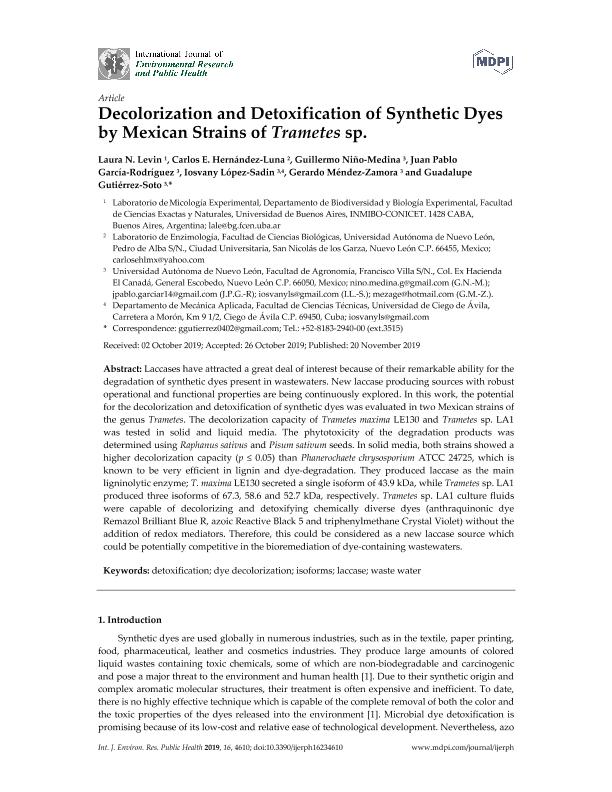Artículo
Decolorization and detoxification of synthetic dyes by mexican strains of trametes sp
Levin, Laura Noemí ; Hernández Luna, Carlos E.; Niño Medina, Guillermo; García Rodríguez, Juan Pablo; López Sadin, Iosvany; Méndez Zamora, Gerardo; Gutiérrez Soto, Guadalupe
; Hernández Luna, Carlos E.; Niño Medina, Guillermo; García Rodríguez, Juan Pablo; López Sadin, Iosvany; Méndez Zamora, Gerardo; Gutiérrez Soto, Guadalupe
 ; Hernández Luna, Carlos E.; Niño Medina, Guillermo; García Rodríguez, Juan Pablo; López Sadin, Iosvany; Méndez Zamora, Gerardo; Gutiérrez Soto, Guadalupe
; Hernández Luna, Carlos E.; Niño Medina, Guillermo; García Rodríguez, Juan Pablo; López Sadin, Iosvany; Méndez Zamora, Gerardo; Gutiérrez Soto, Guadalupe
Fecha de publicación:
10/2019
Editorial:
Molecular Diversity Preservation International
Revista:
International Journal of Environmental Research and Public Health
ISSN:
1660-4601
Idioma:
Inglés
Tipo de recurso:
Artículo publicado
Clasificación temática:
Resumen
Laccases have attracted a great deal of interest because of their remarkable ability for the degradation of synthetic dyes present in wastewaters. New laccase producing sources with robust operational and functional properties are being continuously explored. In this work, the potential for the decolorization and detoxification of synthetic dyes was evaluated in two Mexican strains of the genus Trametes. The decolorization capacity of Trametes maxima LE130 and Trametes sp. LA1 was tested in solid and liquid media. The phytotoxicity of the degradation products was determined using Raphanus sativus and Pisum sativum seeds. In solid media, both strains showed a higher decolorization capacity (p ≤ 0.05) than Phanerochaete chrysosporium ATCC 24725, which is known to be very efficient in lignin and dye-degradation. They produced laccase as the main ligninolytic enzyme; T. maxima LE130 secreted a single isoform of 43.9 kDa, while Trametes sp. LA1 produced three isoforms of 67.3, 58.6 and 52.7 kDa, respectively. Trametes sp. LA1 culture fluids were capable of decolorizing and detoxifying chemically diverse dyes (anthraquinonic dye Remazol Brilliant Blue R, azoic Reactive Black 5 and triphenylmethane Crystal Violet) without the addition of redox mediators. Therefore, this could be considered as a new laccase source which could be potentially competitive in the bioremediation of dye-containing wastewaters.
Palabras clave:
DETOXIFICATION
,
DYE DECOLORIZATION
,
ISOFORMS
,
LACCASE
,
WASTE WATER
Archivos asociados
Licencia
Identificadores
Colecciones
Articulos(INMIBO (EX - PROPLAME))
Articulos de INSTITUTO DE MICOLOGIA Y BOTANICA
Articulos de INSTITUTO DE MICOLOGIA Y BOTANICA
Citación
Levin, Laura Noemí; Hernández Luna, Carlos E.; Niño Medina, Guillermo; García Rodríguez, Juan Pablo; López Sadin, Iosvany; et al.; Decolorization and detoxification of synthetic dyes by mexican strains of trametes sp; Molecular Diversity Preservation International; International Journal of Environmental Research and Public Health; 16; 23; 10-2019; 1-14
Compartir
Altmétricas



